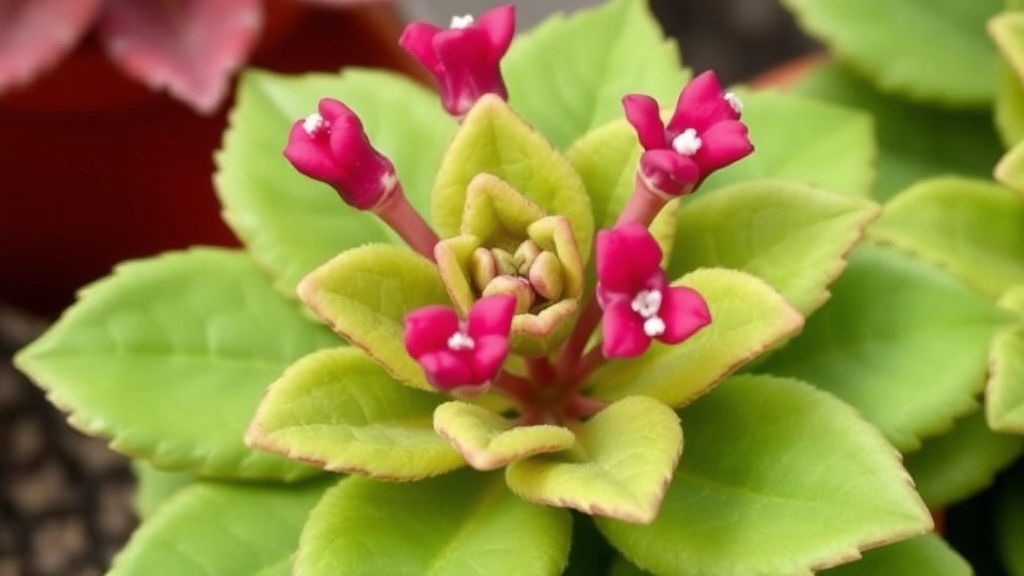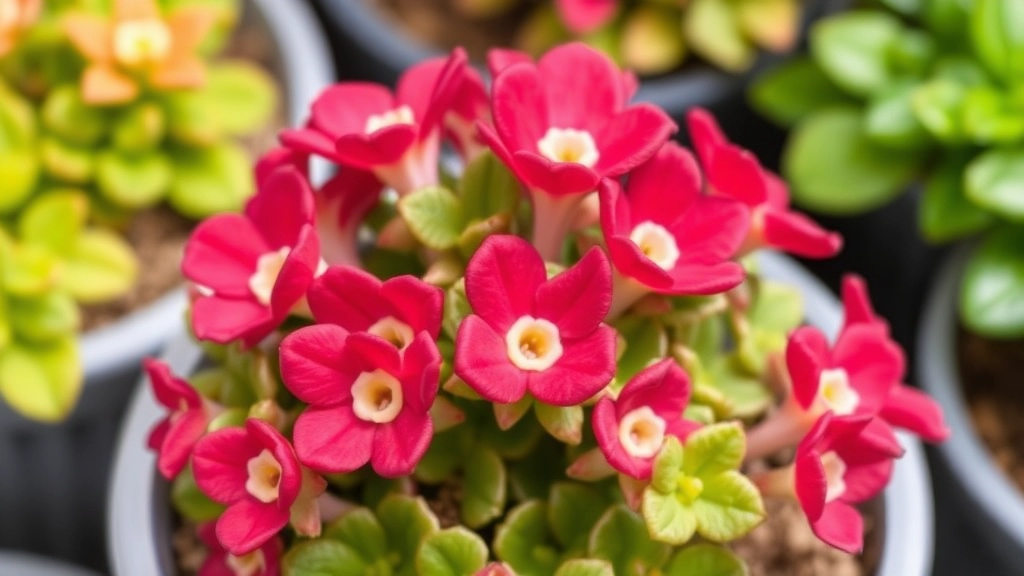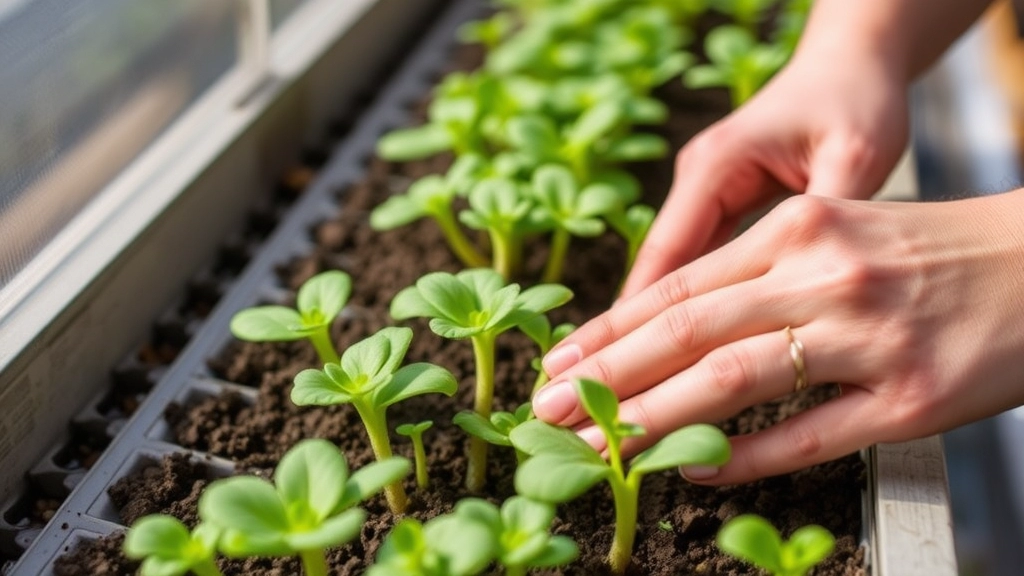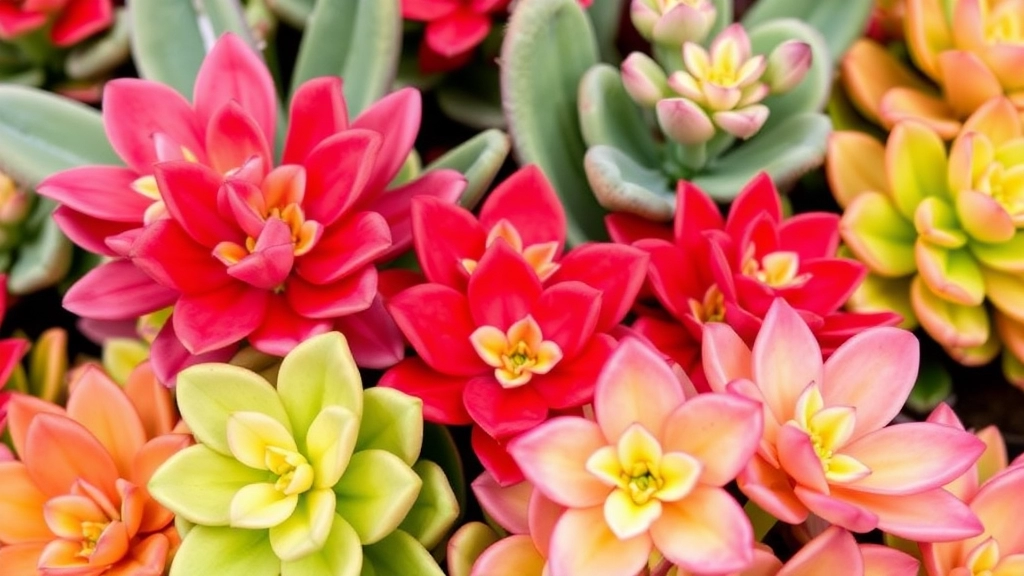Welcome, plant enthusiasts!
Today, we’re diving into the fascinating world of Kalanchoe beharensis varieties. As an avid succulent lover, I’m thrilled to share my insights on these unique and striking plants. From their impressive size to their velvety leaves, Kalanchoe beharensis varieties are true showstoppers in any collection. In this article, we’ll explore their distinctive features, popular varieties, care requirements, and much more.
Whether you’re a seasoned gardener or a curious beginner, you’ll find valuable information on cultivating these magnificent succulents. We’ll cover everything from propagation techniques to seasonal care tips, helping you become a Kalanchoe beharensis expert. So, let’s embark on this green journey together and discover why these plants are capturing the hearts of plant lovers worldwide!
Overview of Kalanchoe Beharensis
Let’s chat about Kalanchoe Beharensis, shall we?
This plant’s a bit of a showstopper in the succulent world.
Hailing from Madagascar, it’s got a nickname that’ll make you chuckle – “Elephant’s Ear Kalanchoe”.
Why? Well, its leaves are massive and fuzzy, just like an elephant’s ear.
But here’s the kicker – it’s not just big, it’s HUGE.
We’re talking about a succulent that can grow up to 6 meters tall in the wild.
That’s like two double-decker buses stacked on top of each other!
Now, I know what you’re thinking. “Will it take over my garden?”
Don’t worry, mate. In cultivation, it’s usually much more manageable.
Still, it’s a proper statement plant that’ll have your neighbours talking.
The Kalanchoe Beharensis is part of the Crassulaceae family.
It’s a tough cookie, drought-resistant and perfect for those of us who forget to water sometimes.
(Guilty as charged!)
But here’s the real magic:
- It’s got these silvery-green leaves that look almost metallic
- The undersides are often a rusty brown colour
- And when it flowers? Expect small, bell-shaped blooms in yellow or orange
It’s like nature’s own sculpture, I tell you.
So, whether you’re a succulent newbie or a seasoned pro, Kalanchoe Beharensis is worth a look.
It’s a plant that’ll make you stop and stare, guaranteed.
Distinctive Features of Kalanchoe Beharensis

Let’s dive into what makes Kalanchoe Beharensis stand out from the crowd. Trust me, this plant’s got some serious swagger!
First off, the leaves. Holy moly, they’re massive! We’re talking dinner plate-sized foliage that’ll make your other plants look like they’ve been hitting the shrink ray. But it’s not just about size – these bad boys are covered in a fuzzy, silvery-white coating that feels like velvet. I swear, every time I touch them, I half expect them to purr!
Now, let’s chat about the shape. The leaves are triangular, almost like arrowheads, and they’ve got these cool scalloped edges. It’s like Mother Nature decided to get artsy with a pair of pinking shears.
But here’s where it gets really wild:
- The stems are thick and woody, giving the plant a tree-like appearance
- As it grows, it sheds lower leaves, creating a palm tree vibe
- The plant can reach heights of up to 6 feet (1.8 meters) indoors – talk about a statement piece!
And don’t even get me started on the flowers. When this beauty decides to bloom, it puts on a show with clusters of small, bell-shaped flowers in shades of yellow or orange. It’s like a fireworks display, but for plant nerds.
One more thing that sets Kalanchoe Beharensis apart is its drought tolerance. This tough cookie can handle dry spells like a champ, making it perfect for forgetful waterers (guilty as charged!).
So, if you’re after a plant that’s got personality in spades and looks like it’s been plucked straight from an alien landscape, Kalanchoe Beharensis is your guy. Trust me, once you’ve got one of these in your collection, you’ll be wondering how you ever lived without its distinctive features. And if you’re curious about other unique Kalanchoe varieties, you might want to check out the Kalanchoe Beharensis tree form for an even more impressive display.
Popular Varieties of Kalanchoe Beharensis
Let’s dive into the world of Kalanchoe beharensis varieties, shall we?
These succulents are like the cool kids of the plant world.
Each one’s got its own unique flair, and I’m here to spill the tea on the most popular ones.
Kalanchoe ‘Fang’
This bad boy’s got teeth, literally.
Its leaves have these wicked serrated edges that look like fangs.
It’s a real conversation starter, trust me.
Kalanchoe ‘Elephant Ears’
Imagine elephant ears, but make them velvety.
That’s what you get with this variety.
Big, soft leaves that’ll make you want to pet your plant (weird, but true).
Kalanchoe ‘Felt Bush’
Ever wanted to touch a cloud? This is as close as you’ll get.
Its leaves are covered in tiny white hairs, giving it a fuzzy, felt-like texture.
Kalanchoe ‘Bronze Sculpture’
This one’s for the artsy folks.
Its leaves have this gorgeous bronze colour that looks like a fancy sculpture.
Kalanchoe ‘Oak Leaf’
Shaped like oak leaves (surprise, surprise), this variety adds a touch of woodland charm.
It’s like bringing a bit of the forest into your home.
These varieties are just the tip of the iceberg.
Each one brings something special to the table (or windowsill).
Whether you’re after texture, colour, or shape, there’s a Kalanchoe beharensis variety out there for you.
So, which one’s caught your eye?
Growth Requirements for Kalanchoe Beharensis Varieties

Let’s chat about what these funky Kalanchoe Beharensis plants need to thrive. Trust me, once you get the hang of it, it’s a breeze.
Light: These suckers love the sun
- Full sun to partial shade is their jam
- Indoors? Pop ’em near a bright window
- Too much shade? You’ll end up with leggy, sad plants
Soil: Well-draining is the name of the game
- Mix regular potting soil with sand or perlite
- Cactus mix works great too
- Avoid heavy, waterlogged soil like the plague
Water: Less is more, folks
- Let the soil dry out between waterings
- Overwatering? That’s a one-way ticket to root rot
- During winter, cut back even more
Temperature: They’re not fans of the cold
- Keep ’em above 10°C (50°F)
- Ideal range: 15-24°C (60-75°F)
- Can handle brief dips, but don’t push it
Humidity: Not fussy, thank goodness
- Average room humidity is fine
- No need for misting or humidifiers
Fertilizer: A little boost goes a long way
- Feed during growing season (spring and summer)
- Use a balanced, water-soluble fertilizer
- Dilute to half strength to avoid burning
Pruning: Keep ’em in check
- Trim leggy growth to maintain shape
- Remove dead or damaged leaves
- Use clean, sharp scissors to avoid infections
Here’s the deal: Kalanchoe Beharensis varieties are pretty chill when it comes to care. They’re not drama queens like some other plants (looking at you, orchids). Just remember, they’re succulents at heart. Treat ’em like desert dwellers, and you’ll be golden.
Got a Kalanchoe that’s looking a bit peaky? Nine times out of ten, it’s down to overwatering. Ease up on the H2O, and you’ll see a difference in no time.
Bottom line: These Kalanchoe Beharensis varieties are tough cookies. Give ’em the basics – sun, well-draining soil, and a light touch with the watering can – and they’ll reward you with those wild, velvety leaves that’ll make your panda plant pals green with envy.
Common Pests and Diseases
Let’s chat about the nasty critters and ailments that can mess with your Kalanchoe beharensis.
Trust me, I’ve seen my fair share of plant troubles, and these succulents aren’t immune.
Pests:
- Mealybugs: These little cotton-ball lookalikes love to suck the life out of your plants.
- Spider mites: Tiny but mighty, they’ll leave your leaves looking speckled and sad.
- Scale insects: They’re like tiny armoured tanks, latching onto stems and leaves.
Diseases:
- Root rot: Overwatering is the culprit here. Your plant’s roots can’t breathe and start to decay.
- Powdery mildew: Looks like someone dusted your plant with flour. Not cool.
- Leaf spot: Brown or black spots on leaves? Yep, that’s leaf spot for you.
How to deal?
For pests, I swear by neem oil. It’s like kryptonite for bugs.
Diseases? Prevention is key. Don’t overwater, give your plant some space to breathe.
If you spot trouble early, you can often just snip off the affected parts.
Remember, a healthy Kalanchoe beharensis is more resistant to pests and diseases.
So, keep it happy with proper care, and you’ll have fewer headaches down the road.
Propagation Techniques

Let’s dive into how to make more of these funky Kalanchoe beharensis plants, shall we? It’s not rocket science, but there are a few tricks up my sleeve that’ll make your life easier.
Leaf Cuttings: The Easy-Peasy Method
Here’s the deal with leaf cuttings:
- Snip off a healthy leaf
- Let it dry for a day or two (trust me on this)
- Stick it in some well-draining soil
- Water sparingly and wait
It’s like magic – little plantlets will pop up at the base of the leaf. Patience is key here, folks. Don’t get antsy and overwater.
Stem Cuttings: For When You’re Feeling Brave
Stem cuttings are a bit more hardcore:
- Cut a 4-6 inch piece from a healthy stem
- Remove lower leaves
- Let it callous over for a few days
- Plant in a mix of perlite and cactus soil
Pro tip: Dip the cut end in rooting hormone if you want to speed things up. It’s like giving your cutting a little pep talk.
Division: The “Divide and Conquer” Approach
Got a big, bushy Kalanchoe? Here’s how to split it:
- Carefully remove the plant from its pot
- Gently separate the roots
- Replant each section in its own pot
It’s like giving your plant roommates their own flats. Everyone’s happier with more space.
Seeds: For the Patient Gardener
Honestly, I rarely bother with seeds. They’re finicky and take forever. But if you’re dead set on it:
- Sow seeds on the surface of well-draining soil
- Keep them warm and slightly moist
- Wait… and wait some more
Remember, Kalanchoe beharensis propagation isn’t a race. Take your time, enjoy the process, and before you know it, you’ll have more plants than you know what to do with. Trust me, I’ve been there! If you’re interested in other varieties, you might want to check out the Kalanchoe tomentosa for its unique watering needs.
Seasonal Care Tips for Kalanchoe Beharensis
Let’s chat about keeping your Kalanchoe beharensis happy all year round.
These succulents are tough cookies, but they still need a bit of TLC.
Spring: Wake-up time!
- Gradually increase watering as days get longer
- Start feeding with a balanced, diluted fertiliser
- Prune any winter-damaged or leggy growth
Summer: Showtime!
- Water deeply but less frequently
- Protect from scorching midday sun
- Watch for pests – they love the warm weather too
Autumn: Winding down
- Reduce watering as growth slows
- Stop fertilising
- Bring indoor plants away from cold windows
Winter: Chill out
- Water sparingly – just enough to prevent shrivelling
- Keep in a bright spot, but away from cold drafts
- No fertiliser needed – let ’em rest
Pro tip: Always check the soil before watering. These guys hate wet feet!
Remember, Kalanchoe beharensis is a tough plant, but it’s not invincible.
Keep an eye out for changes and adjust your care accordingly.
Got any specific seasonal issues with your Kalanchoe? Drop a comment, and let’s sort it out together!
Landscaping Ideas with Kalanchoe Beharensis
Let’s chat about sprucing up your garden with Kalanchoe beharensis. This plant’s a real showstopper, and I’ve got some killer ideas on how to make it shine in your outdoor space.
Focal Point Power
First up, let’s talk about using Kalanchoe beharensis as a focal point. Trust me, this plant’s got the wow factor to pull it off:
- Plop it in a large, eye-catching pot near your entrance
- Use it as a centrepiece in a rock garden
- Plant it solo in a raised bed for maximum impact
Texture Play
The fuzzy leaves of Kalanchoe beharensis are begging to be paired with other textures:
- Mix it with smooth-leaved succulents for contrast
- Plant it near grasses for a fun textural mix
- Pair it with spiky plants like agave for a tactile explosion
Colour Combos
While Kalanchoe beharensis isn’t known for flashy flowers, its leaves can create some cool colour schemes:
- Plant it with purple-leaved plants for a moody vibe
- Pair it with bright green succulents for a fresh look
- Use it as a backdrop for colourful flowering plants
Vertical Interest
Don’t forget, this plant can get tall! Use that height to your advantage:
- Plant it at the back of borders for a layered look
- Use it to create privacy screens
- Grow it against a wall for a living sculpture effect
Container Gardening
Kalanchoe beharensis is a champ in containers. Here’s how to make the most of it:
- Group several pots of different sizes for a dynamic display
- Use it in a large planter with trailing plants for contrast
- Create a succulent container garden with Kalanchoe as the star
Remember, Kalanchoe beharensis loves sun and well-draining soil, so keep that in mind when planning your landscape. And don’t be afraid to get creative â this plant’s unique look can handle bold design choices.
So, ready to give your garden a Kalanchoe beharensis makeover? Trust me, once you start playing around with this plant, you’ll be hooked on its versatility and striking appearance. It’s a game-changer in landscaping, whether you’re going for a desert vibe or just want to add some serious texture to your outdoor space. If you’re interested in other unique Kalanchoe varieties, you might want to check out the Kalanchoe tomentosa varieties for more inspiration.
Indoor vs. Outdoor Cultivation
Let’s chat about growing Kalanchoe Beharensis indoors and outdoors.
It’s a versatile plant, but there are some key differences to keep in mind.
Indoor Cultivation:
- Light: These guys love bright, indirect light. A sunny windowsill works wonders.
- Temperature: Keep it cozy, around 18-24°C (65-75°F).
- Humidity: They’re not fussy, but a bit of extra humidity doesn’t hurt.
- Watering: Less is more. Let the soil dry out between waterings.
- Space: They can get big, so give ’em room to grow.
Outdoor Cultivation:
- Climate: Thrives in warm, dry areas. Think USDA zones 9-11.
- Sun: Partial shade to full sun, depending on your local climate.
- Soil: Well-draining is key. Add some grit or sand to your mix.
- Watering: Nature often takes care of this, but keep an eye out during dry spells.
- Protection: Shelter from frost and heavy rain.
The big difference? Outdoors, your Kalanchoe Beharensis can really stretch its legs.
Indoors, you’ll need to manage its size more actively.
Either way, these funky plants are a joy to grow.
Just remember: whether inside or out, Kalanchoe Beharensis needs plenty of light and not too much water.
Frequently Asked Questions about Kalanchoe Beharensis Varieties
Let’s dive into some burning questions about Kalanchoe Beharensis varieties. I’ve chatted with countless plant enthusiasts, and these are the queries that pop up time and time again. So, grab a cuppa, and let’s get stuck in!
Q1: “How often should I water my Kalanchoe Beharensis?”
Alright, here’s the deal: these succulents are pretty chill when it comes to water. They’re like that friend who’s always up for a drink but doesn’t need one to have a good time. In general, water them when the soil’s dry about an inch deep. During summer, that might be once a week. In winter, you can slack off a bit – maybe once every two or three weeks.
Q2: “Can I grow Kalanchoe Beharensis indoors?”
Absolutely! These tough cookies can thrive indoors if you give them enough light. Pop them near a sunny window, and they’ll be happy as Larry. Just remember, they can get pretty big, so make sure you’ve got the space.
Q3: “Why are my Kalanchoe Beharensis leaves turning yellow?”
Uh-oh, yellow leaves are usually a sign your plant’s not loving life. Common culprits include:
- Overwatering (the most likely suspect)
- Not enough light
- Nutrient deficiency
- Pest problems
Check these off one by one, and you’ll likely find your culprit.
Q4: “How big do Kalanchoe Beharensis plants get?”
Hold onto your hat – these bad boys can get huge! In their natural habitat, they can reach up to 6 metres tall. But don’t panic, in pots or indoor settings, they’re more likely to top out at about 1-2 metres.
Q5: “Is Kalanchoe Beharensis toxic to pets?”
Sadly, yes. Like many Kalanchoe species, K. Beharensis contains compounds that can be harmful if ingested. If you’ve got curious pets, it’s best to keep these plants out of reach or opt for pet-friendly alternatives.
Q6: “How do I propagate my Kalanchoe Beharensis?”
It’s dead easy, mate! You can propagate these from stem cuttings or even leaves. Here’s a quick how-to:
- Cut a healthy stem or leaf
- Let it callous over for a day or two
- Stick it in some well-draining soil
- Water sparingly until roots develop
Before you know it, you’ll have a new plant!
Q7: “My Kalanchoe Beharensis is getting leggy. What’s going on?”
Sounds like your plant’s reaching for the stars – or more accurately, for more light. When they don’t get enough sunshine, they stretch out, trying to find more. Move your plant to a brighter spot, and consider pruning it back to encourage bushier growth.
Remember, growing Kalanchoe Beharensis varieties is more art than science. Don’t be afraid to experiment and find what works best for you and your plant. Happy growing!
Frequently Asked Questions about Kalanchoe Beharensis Varieties
Q1: How tall can Kalanchoe Beharensis grow?
In its natural habitat, Kalanchoe Beharensis can reach impressive heights of up to 6 meters (20 feet). However, when grown in containers or indoors, it typically stays more manageable, reaching heights of 1-2 meters (3-6 feet).
Q2: Are there different varieties of Kalanchoe Beharensis?
Yes, there are several varieties of Kalanchoe Beharensis, each with unique characteristics. Some popular varieties include:
- ‘Fang’ – known for its serrated leaf edges
- ‘Felt Bush’ – recognized for its velvety texture
- ‘Bronze Sculpture’ – admired for its bronze-colored leaves
Q3: How often should I fertilize my Kalanchoe Beharensis?
Fertilize your Kalanchoe Beharensis during the growing season (spring and summer) about once a month with a balanced, water-soluble fertilizer diluted to half strength. Avoid fertilizing in winter when the plant’s growth slows down.
Q4: Can Kalanchoe Beharensis tolerate cold temperatures?
Kalanchoe Beharensis is not frost-hardy and prefers warmer temperatures. It can tolerate brief exposure to temperatures as low as 10°C (50°F), but it’s best to keep it above 15°C (60°F) for optimal growth. If you live in a colder climate, bring your plant indoors during winter.
Q5: How do I propagate Kalanchoe Beharensis?
Kalanchoe Beharensis can be propagated through leaf or stem cuttings. Allow the cuttings to callous over for a few days before planting in well-draining soil. Water sparingly until roots develop. This method is generally more successful than growing from seeds.
Q6: Why are my Kalanchoe Beharensis leaves dropping?
Leaf drop in Kalanchoe Beharensis can be caused by several factors:
- Overwatering or poor drainage
- Sudden temperature changes
- Insufficient light
- Pest infestations
Check these potential issues and adjust your care routine accordingly.
Q7: Is Kalanchoe Beharensis suitable for beginners?
Yes, Kalanchoe Beharensis is generally considered suitable for beginners. It’s drought-tolerant and relatively low-maintenance. However, it’s important to provide proper light conditions and avoid overwatering to ensure the plant thrives.

